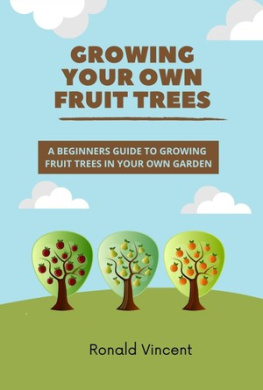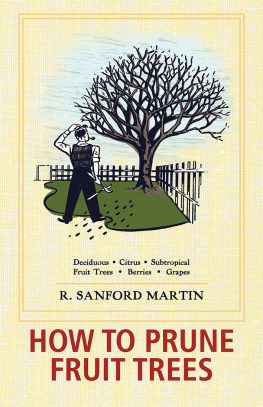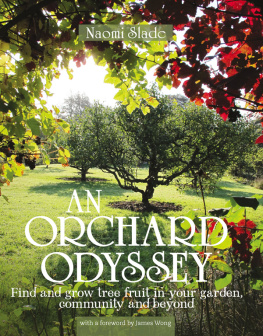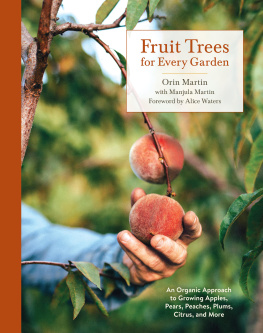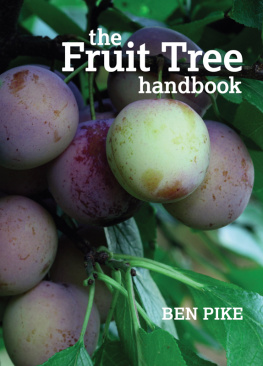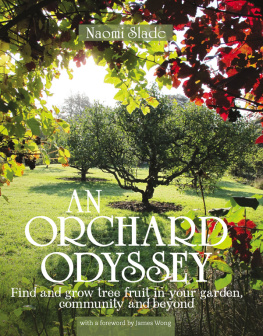

Fruit TREES IN SMALL SPACES
Abundant Harvests from your own Backyard
Colby Eierman
with photos by Erin Kunkel
and recipes by Mike Emanuel

Copyright 2012 by Colby Eierman. All rights reserved.
Photo and illustration credits appear on .
Hand-lettering by Joel Holland.
Book design by Mark Searcy.
Published in 2012 by Timber Press, Inc.
The Haseltine Building
133 S.W. Second Avenue, Suite 450
Portland, Oregon 97204-3527
timberpress.com
2 The Quadrant
135 Salusbury Road
London NW6 6RJ
timberpress.co.uk
Printed in China
Library of Congress Cataloging-in-Publication Data
Eierman, Colby.
Fruit trees in small spaces: abundant harvests from your own backyard/Colby
Eierman; with photos by Erin Kunkel.1st ed.
p. cm.
Includes bibliographical references and index.
ISBN 978-1-60469-190-0
1. Fruit trees. 2. Fruit. 3. Backyard gardens. 4. Orchards. I. Title. II. Title:
Abundant harvests from your own backyard.
SB355.E42 2012
634dc23
2011042489
Catalog records for this book are available from the British Library.

Foreword
by Rosalind Creasy
I first met Colby in the magnificent garden at COPIA, which was known for its dedication to understanding and celebrating American food, wine, and arts. It was 2004 and I was there to photograph fruit trees. The gardens were beautiful, the fruit trees were in a unique landscaped setting, and I needed photographs to offer inspiration for home gardeners for my book Edible Landscaping.
Everything was so well grown and there were so many unusual things that I sought out the gardener to learn more. Most of the trees were small, with many of them in containersso appropriate for the home gardener. There was an espaliered quince, something Id never seen before. Apples, plums, cherries, and peaches along with different citrus were planted in stop-you-in-your-tracks rusted containers. There were 3-in-1 plantings, a fabulous way to grow a variety of fruits in a small space. It was a luxury to see so many fruits in one place at one time, and to see so many ideas for growing these fruits in a small space.
After 30 years of experience as a landscape designer, I knew that most people want smaller fruit trees for any number of reasons: size of yards, limited time, and the desire to have a wide variety of fruits rather than one single fruit tree that dominates the yard and overwhelms the gardener with a surplus of fruit. Unfortunately, for decades now, most of the information on growing fruit trees, both in books and online, has been aimed at people who are maintaining single-crop orchards.
This book, on the other hand, focuses on growing multiple orchard fruits as part of the landscape in todays smaller gardens. Home gardeners will find they can grow the fruit they love, and plenty of it, even if their yards are small. Growing instructions include selected information for different climates and conditions. Colbys experience with the trees themselves and the techniques required to grow them in a smaller space means that he is also a master pruner. He understands how to grow and prune trees for the best looks and highest fruit production. With this book, he brings this knowledge and expertise to help home gardeners get the best from their trees.
To round out the book, there are the recipes. Cookbooks generally overlook homegrown fruits, and yet thats where the treasure is. Sadly, most home gardeners, even when they grow some of their own fruit, dont know how to harvest at the peak of perfection. Colby guides us through this critical step, and then takes it a giant step further by giving us both time-honored recipes, such as poached pears and fruit jams and leathers, and going way beyond with new approaches.
Even with my years of experience, I discovered new techniques. When the apple tree is in full harvest, I no longer have to rely on applesauce to take care of the overflow. With the recipes in this imaginative collection, I now can branch out from applesauce to make apple chips or get past apple pie with just solo apples and add other fruits on a crunchy galette base. Who knew that peach leaves could be used to flavor wine or that gardeners in cold climates, whose container-grown lemon might not produce much in the way of fruit, can take full advantage of their plants by harvesting their leaves to make an incredible syrup to be used as part of a spritzer or brushed between the layers of a lemon chiffon cake?
Most of all, this book is a great primer, easy to use, and easy to understand. It demonstrates that growing fruit trees need not be a daunting task, with reliable information based on experience and with an emphasis on organic growing. Soon youll be showing off your heirloom apples or latest variety of pluot, introducing friends to the unique taste of the kumquat, taking the plunge and learning to make a true fruit jam, or harvesting peach leaves to see just what they add to wine.
Acknowledgments
I must start with a short word of gratitude to my family, who make everything worthwhile. Thanks first to my wife, Megan, who knew I wanted to see this book through and provided the time and encouragement for me to do that. And to my sons, Peter and Henry, thank you so much for being patient and for not spilling anything on my computer.
This book has been nothing if not a collective effort, and working on it has reinforced my belief that generosity and collaboration are qualities to be cherished, cultivated, and sought out in all endeavors. All the folks involved have brought an enthusiastic spirit in contributing to this common and simple notion: that it is good, beautiful, delicious, and fun to grow some of our own fruit at home.
This book would not exist without the steady research and writing support of Marianne Lipanovich. I am endlessly grateful for her keen sensibilities and solid plant knowledge. Mariannes bright and easy-going way comes through in Part Two of this book.
For good reason, Erin Kunkel is one of the most sought-after photographers in the San Francisco Bay Area and beyond. She was the first person I thought of for this project and I am so glad she was willing to sign on. Erin knows plants and brings an artists eye to even the most pragmatic shot. The calm and steady way in which she works was a welcome and inspiring part of this process.
Chef Mike Emanuel brought the recipe section of this book into fruition with a collection of recipes that help bring out and/or preserve the best of homegrown fruit. Mike and his wife, Jenny, are the consummate hosts, and their cooking always takes advantage of the best the season has to offer. I am so thankful for their friendship and contribution to this book.
Mike Tomlinson of Dave Wilson Nursery generously provided photographs of specific fruit varieties. Pattiann Koury and Aya Brackett kindly supplied photographs that helped to make the text visually complete.
Richi Meecham and Degge Hays both bigheartedly opened up their gardens for us to photograph and explore. Degge has also been my trusted council on pruning, variety selection, and most any garden topic that comes to mind. Ed Laivo of Devil Mountain Nursery offered his reflections on backyard orchard culture and has, over the years, been a fountain of fruit tree knowledge.
Next page

